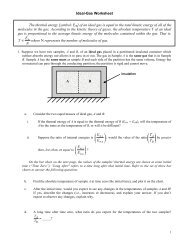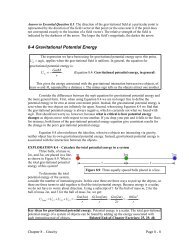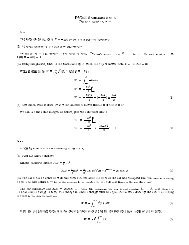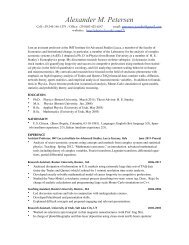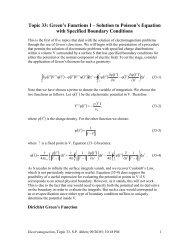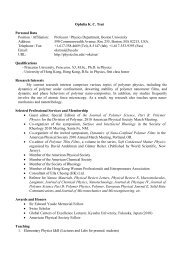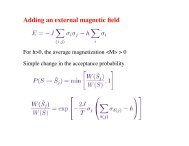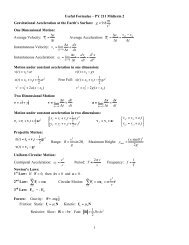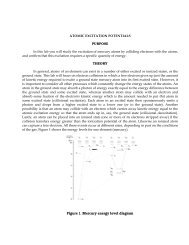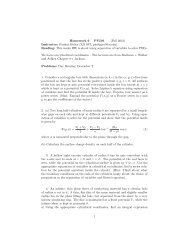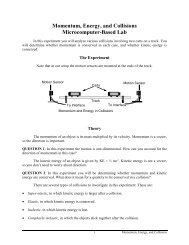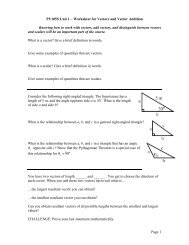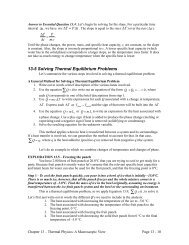Crystal Structure 1 3.1 Some Basic Concepts of Crystal Structure ...
Crystal Structure 1 3.1 Some Basic Concepts of Crystal Structure ...
Crystal Structure 1 3.1 Some Basic Concepts of Crystal Structure ...
Create successful ePaper yourself
Turn your PDF publications into a flip-book with our unique Google optimized e-Paper software.
<strong>Crystal</strong> <strong>Structure</strong><br />
To evaluate the integral in eqn. <strong>3.1</strong>1, we will exploit the fact that n(r) is periodic, i.e.<br />
invariant under translation along any lattice vectors (which must be a linear combinations<br />
<strong>of</strong> the Bravais primitive vectors, a, b, and c.) Under this condition, the Fourier expansion<br />
<strong>of</strong> n(r) will be:<br />
G must be such that<br />
<br />
<br />
n( r ) n exp( iG r ) where (<strong>3.1</strong>3)<br />
<br />
G<br />
G<br />
n(r + ma + nb + pc) = n(r) for integers m, n, p. (<strong>3.1</strong>4)<br />
Here, n G is given by the Fourier transformation <strong>of</strong> n(r):<br />
n G = (1/V) dV n(r) exp[iGr] (<strong>3.1</strong>5)<br />
Eqn. <strong>3.1</strong>5 can be shown to be consistent with eqn. <strong>3.1</strong>3. We will now show that G must<br />
be a reciprocal lattice vector, i.e.<br />
G = jA + kB + lC (<strong>3.1</strong>6)<br />
where j, k, l are integers, and A, B, C are as defined in eqn. 3.6. Substitute eqn. <strong>3.1</strong>4 in<br />
eqn. <strong>3.1</strong>6, we have:<br />
<br />
<br />
<br />
n( r ) n exp( iG r ) n exp( iG r )exp[ iG ( ma nb pc)]<br />
n(<br />
r ma nb pc)<br />
<br />
<br />
G<br />
G<br />
Eqn. <strong>3.1</strong>7 is valid only if:<br />
<br />
<br />
G<br />
G<br />
(<strong>3.1</strong>7)<br />
G(ma + nb + pc) = 2M<br />
<br />
where M is an integer. Let’s write G as a linear combination <strong>of</strong> A, B, and C, as in eqn.<br />
<strong>3.1</strong>6, but putting no restriction on j, k, l. If we find in the end that j, k, l have to be<br />
integers, G must then be a reciprocal lattice vector. Substitute eqn. <strong>3.1</strong>6 in eqn. <strong>3.1</strong>8, and<br />
use the following relations, which are straightforward to verify:<br />
Then we have:<br />
aA = bB = cC = 2<br />
aB = aC = bA = bC = cA = c B = 0. (<strong>3.1</strong>9)<br />
jm + kn + lp = M<br />
21



![arXiv:1303.7274v2 [physics.soc-ph] 27 Aug 2013 - Boston University ...](https://img.yumpu.com/51679664/1/190x245/arxiv13037274v2-physicssoc-ph-27-aug-2013-boston-university-.jpg?quality=85)
